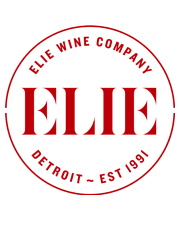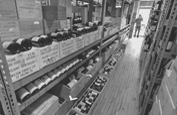Pinot Noir with Muscles — New Vintage Gevrey-Chambertin from Domaine Dominique Gallois
Gevrey-Chambertin is one of the most recognized appellations in Burgundy for good reason. At the commune level, these can be immensely satisfying Pinot Noir-based wines, substantial, dark-hued, infused with assertive fruit and heady aromatics. The distinction of Gevrey-Chambertin becomes unmistakable in the Premier Cru and Grand Cru vineyards. There you find the muscularity and structure that sets this appellation apart from all others.
 Fourth-generation winemaker Dominique Gallois took over the family vineyards from his father in 1989. The small domaine is around 10 acres, the bulk of which is centered in Gevrey-Chambertin. The Gallois cellars were constructed by Dominique’s great grandfather, Guillaume Bizot, in 1901. They are reputed to be some of the coldest in the region, which helps to create wines of great depth and longevity.
Fourth-generation winemaker Dominique Gallois took over the family vineyards from his father in 1989. The small domaine is around 10 acres, the bulk of which is centered in Gevrey-Chambertin. The Gallois cellars were constructed by Dominique’s great grandfather, Guillaume Bizot, in 1901. They are reputed to be some of the coldest in the region, which helps to create wines of great depth and longevity.
Cultivation and winemaking are aimed at producing wines that are pure and speak of their unique terroir. In the vineyards, the domain has adapted a lutte raisonée (reasoned struggle) approach that includes plowing to force the roots deep and minimal use of herbicides or pesticides. Harvesting and sorting are all done by hand. In the cellar, only indigenous yeasts transform the fruit into wine. The wines are aged in oak barrels from the Allier region, with care to ensure that the portion of new oak, which varies depending on the vineyard parcels, does not dominate the wine’s aromas.
2016 was no parade for producers in Burgundy. A frost blanket and recurring mildew plagued growers throughout the season. Despite these issues, the Côte d’Or has once again provided an outstanding, classic vintage featuring some hauntingly beautiful red wines.
Special prices based on purchase of 6-pack (mix-and-match)
 ~$67 Gevrey-Chambertin (2016)
~$67 Gevrey-Chambertin (2016)
A true taste of the appellation, the wine is a blend from 10 climats situated around the village of Gevrey-Chambertin including En Songe, En Jouise, En Billard, En Dérée, Croix des Champs, Sylvie, La Justice, Charreux, and two parcels of the clos surrounding the Gallois home. Average age of vines from these parcels is around fifty years. 800 cases annual production.
 $117 “La Combe Aux Moines” (Gevrey-Chambertin, Premier Cru 2016)
$117 “La Combe Aux Moines” (Gevrey-Chambertin, Premier Cru 2016)
One of Gallois’ most sought after offerings, the “La Combe Aux Moines” Premier Cru vineyard is comprised of shallow clay-limestone on slabs of rock, with very little topsoil. The vines, planted in 1954, are on steep slopes at around 1,000 feet in elevation that are ideally exposed to morning sunshine. Yields from this parcel are naturally low and the ideal climat helps ripen the fruit to perfection. 200 cases annual production.
 $225 Charmes-Chambertin (Grand Cru 2016)
$225 Charmes-Chambertin (Grand Cru 2016)
Seriously old vines planted in 1910 from a climat that produces some of the most powerful and elegant expressions of Pinot Noir on earth. Gallois’ tiny 0.7 acre parcel is near the border of the Grand Cru Griotte-Chambertin and Dominique claims this wine has all of “the elegance of Charmes, the power of Chambertin and the roundness of Griotte.” These are vineyards composed of thin and poor clay-limestone soils that are littered with small stones, marls, and iron. It’s a landscape where Pinot Noir vines thrive. 133 cases annual production.
Ask us about our selection of previous vintages (2005-2015) from Domaine Dominique Gallois.
- - -
Posted on 2019.10.17 in France, Saturday Sips Wines, Burgundy | Read more...
New Vintage Comincioli — Rich and Pure Italian Wines from the Shores of Lake Garda
Although published in 1990 and out-of-print, Burton Anderson’s The Wine Atlas of Italy still offers some of the most insightful observations on Italian wine to be found anywhere. Almost 30 years ago his take on Azienda Agricola Comincioli was that they were an “unsung producer of some of the most consistently impressive” wines in Riviera del Garda — an agricultural zone on the glacial morainic slopes of Lake Garda, known mainly to locals and the cosmopolitan crowd of tourists that flock to this region, one of Italy’s most breathtakingly beautiful. Not much has changed for Comincioli since Burton wrote those words. They are still producing some of the most charming wines in the northeast of Italy to little fanfare from mainstream wine pundits. The good news for wine lovers is that these charming wines are a superb value.
 Along with his wife Elisabetta, and sons Roberto and Andrea, 13th generation farmer Gianfranco Comincioli presides over 34 acres of vineyard and 64 acres of olive groves. Indeed, it is for the amazing (if somewhat controversial) olive oils for which Comincioli is most well-known. But the wines are made with the same painstaking care as the oil — soaked in a philosophy based on an unwavering respect for traditions and the environment. Gianfranco and family are dedicated to not only preserving their region’s indigenous grape varieties but to use them to produce wines of the utmost quality.
Along with his wife Elisabetta, and sons Roberto and Andrea, 13th generation farmer Gianfranco Comincioli presides over 34 acres of vineyard and 64 acres of olive groves. Indeed, it is for the amazing (if somewhat controversial) olive oils for which Comincioli is most well-known. But the wines are made with the same painstaking care as the oil — soaked in a philosophy based on an unwavering respect for traditions and the environment. Gianfranco and family are dedicated to not only preserving their region’s indigenous grape varieties but to use them to produce wines of the utmost quality.
The farm lies in the Valtènesi sub-zone, the most venerated of the district. Valtènesi is distinguished by superior exposure to the sun and moderating breezes from the lake. For context, Comincioli’s vineyards are almost directly across the lake from Valpolicella, where Italy’s famous Amarone is produced. In fact, many of the same techniques for producing Valpolicella are used at Comincioli.
Harvesting the fruit takes place exclusively by hand, using small crates to avoid stress and prevent squashing of the grapes. Hand-sorting is done to remove any inferior fruit. There are four harvests in a single vintage. The first harvest, from the oldest vines, is directed at grapes destined for raisining (drying the grapes before vinification to concentrate the fruit’s sugars and flavors). Subsequent harvests are done on the basis of ripeness, the age of the vines, and the altitude of the vineyard. Work in the cellar is just as meticulous, with concerted effort to avoid any unwanted oxidative effects. The result is a group of unique wines that express both sense of place and purity.
Special prices based on purchase of 6-pack (mix-and-match)

~$22 Comincioli “Riviera” (Riviera del Garda DOC 2014) RED
Drinking at its peak right now, the 2014 cuvée “Riviera” is based on a little over half the native Groppello variety with the remainder a blend of Sangiovese, Marzemino, and Barbera. The wine is aged in stainless steel tanks and oak casks. Full of juicy red and black berries with intoxicating floral and spice aromatics, it’s reminiscent of the Valpolicella Ripasso from the other side of Lake Garda but with a vibe all its own. It’s ideal balance will pair beautifully with most classic Italian pasta dishes.

~$38 Comincioli “Gropél” (Riviera del Garda DOC 2015) RED
A celebration of the native grape variety Groppello rounded out with very small amounts of Sangiovese, Marzemino, and Barbera. A portion of the wine is made in the “appassimento” style of drying the grapes before vinification to concentrate the fruit’s sugars and flavors. It is then aged in stainless steel tanks and oak casks. “Gropél” is a unique red wine that delivers the weight, textures, and concentration of ripe fruit that Amarone lovers cherish, with the aromatics and flavors exclusive of Valtènesi.
 ~$24 Comincioli “Perlì” (Vino Bianco 2017) WHITE
~$24 Comincioli “Perlì” (Vino Bianco 2017) WHITE
The only reason this elegant white is declassified into the humble status of Vino Bianco is because Gianfranco has produced it using only the local indigenous varieties of Trebbiano Valtènesi and Erbamat, both grapes that are not allowed under DOC regulations but were introduced from obscurity into the Comincioli vineyards 30 years ago. One sip of its concentrated fruit and bracing minerality is enough to prove its bona fides as a wine of distinction and longevity. All the citrus, floral, and autumn meadow aromatics will curl your eyebrows. It’s style and grace are reminiscent of the best in Lugana, on the southern shore of Lake Garda. Certainly fans of Sancerre will be impressed.

~$58 Comincioli “Suler” (Riviera del Garda DOC 2011) RED OUT OF STOCK
Valpolicella is on the other side of Lake Garda from Comincioli and is world famous for the production of Amarone in the “appassimento” style. This regional style is uniquely conveyed in the cuvée “Suler.” A mix of Sangiovese, Marzemino, Groppello, and Barbera grapes from Comincioli’s oldest vineyards (40 to 90 years old) are placed in shallow, ventilated crates for a period of 20-30 days before vinification. After extensive aging in stainless steel tanks, oak casks, and finally in the bottle, “Suler” delivers full-bodied elegance.
- - -
Posted on 2019.10.10 in Saturday Sips Wines, Italy, Lombardy | Read more...
New Vintage Red Wines from Artuke — Rapidly Rising Stars of Rioja
One of the most exciting producers in Rioja right now, we’ve always adored the wines from brothers Arturo and Kike de Miguel Blanco, third generation viticulturalists that produce wine for Artuke Bodegas y Viñedos.  It seems that each new vintage highlights just how much growth and improvement can be accomplished when your singular focus is creating wines of freshness and purity that speak of place. Not only are the wines getting better, these new vintages have elegantly updated packaging to match.
It seems that each new vintage highlights just how much growth and improvement can be accomplished when your singular focus is creating wines of freshness and purity that speak of place. Not only are the wines getting better, these new vintages have elegantly updated packaging to match.
With less than 55 total acres of vineyards distributed over 32 different plots, Artuke is most certainly a family affair. Their father still helps with vineyard maintenance, and their mother will have a plate of food at the ready for family members and visitors alike. Yet it is these two young men that have completely refocused the family winery to cultivate small vineyard plots in and around their village of Ábalos in the high elevation foothills of the Cantabrian Mountains.
Although the brothers are already working somewhat outside the established regulations of Rioja, their wines clearly reveal the characteristics of the Alavesa sub-zone, the northernmost and smallest of the three Rioja sub-zones, where the cooling influence of the Atlantic Ocean meets the warmer interior. This unique climate has the effect of ripening Tempranillo grapes with slightly thinner skins, yielding wines with superb fruit and freshness.
All prices based on the purchase of six or more bottles (mix and match).
~$14 “Artuke” (Rioja, 2018)
 “Artuke” is made with the carbonic maceration method, a wine-making technique used to enhance aromatics and produce luscious, fresh, fruity wines preferred by Basques in the northern sub-zone of Alavesa. It is a blend of mainly Tempranillo grapes with about 5% of the white grape, Viura, from vineyards in the village of Baños de Ebro. The wine is fermented and aged in concrete for close to six months before bottling. It smells like a four-berry pie. This mouth-watering red wine takes a relatively deep chill which makes it a versatile pairing with all types of food: tuna, pretty much anything made with zucchini, fried chicken, gooey cheese sandwiches, pizza, etc…
“Artuke” is made with the carbonic maceration method, a wine-making technique used to enhance aromatics and produce luscious, fresh, fruity wines preferred by Basques in the northern sub-zone of Alavesa. It is a blend of mainly Tempranillo grapes with about 5% of the white grape, Viura, from vineyards in the village of Baños de Ebro. The wine is fermented and aged in concrete for close to six months before bottling. It smells like a four-berry pie. This mouth-watering red wine takes a relatively deep chill which makes it a versatile pairing with all types of food: tuna, pretty much anything made with zucchini, fried chicken, gooey cheese sandwiches, pizza, etc…
~$22 “Pies Negros” (Rioja, 2017)
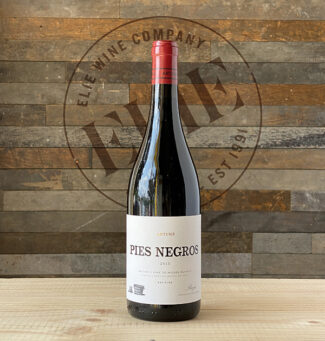 A blend of mostly Tempranillo with a small amount of Graciano from vines as old as 95 years, from vineyards in the village of Ábalos. Pies Negros means Black Feet, a reference to the archaic method of crushing the grapes using one’s feet. Fermented with indigenous yeasts, most of the wine matured in 500-liter oak barrels for one year, with about one-quarter kept in concrete. The wine is especially pretty on the nose with a heady floral scent wrapped around candied fruit and cinnamon. A medium-bodied sip is generous and swells through the midpalate to finish with a touch of earth. A fantastic value that would pair beautifully with kibbeh nayeh.
A blend of mostly Tempranillo with a small amount of Graciano from vines as old as 95 years, from vineyards in the village of Ábalos. Pies Negros means Black Feet, a reference to the archaic method of crushing the grapes using one’s feet. Fermented with indigenous yeasts, most of the wine matured in 500-liter oak barrels for one year, with about one-quarter kept in concrete. The wine is especially pretty on the nose with a heady floral scent wrapped around candied fruit and cinnamon. A medium-bodied sip is generous and swells through the midpalate to finish with a touch of earth. A fantastic value that would pair beautifully with kibbeh nayeh.
- - -
Posted on 2019.10.03 in Saturday Sips Wines, Spain DO, Rioja DOC | Read more...
The Champagne Society October 2019 Selection: Champagne Jacquesson
Champagne Jacquesson “Cuvée No. 736 Dégorgement Tardif” (Extra Brut)
Price for The Champagne Society members: $100 (regular price $150)
Long-time subscribers to The Champagne Society will no doubt be familiar with Champagne Jacquesson’s 700-series created to showcase the character of a particular vintage with the addition of a small amount of reserve wines designed to reinforce the complexity of the base wine. The 700-series is proving to be consistently one of the best non-vintage Champagnes available.
To show you our appreciation, the latest selection for The Champagne Society is a very special bottle of Jacquesson’s 736 Dégorgement Tardif (Late Disgorged) that we are giving to you at just about our cost. While we won’t have any further bottles of 736 Dégorgement Tardif to sell at this price, we will offer the newest 700-series release, Cuvée No. 742, with the normal Champagne Society discount at $75 (regular price $89).
 The base wine for 736 is from the epic 2008 vintage, with about 34% of the blend made with reserves from 2007 and 2006. It’s composed of 53% Chardonnay, 29% Pinot Noir, and 18% Pinot Meunier. The Dégorgement Tardif cuvée is from a handful of 736 that was held back and allowed to age on its lees for a total of almost eight years before disgorgement in November of 2016. This is the type of winemaking focus that you might see in the top wine, or Tête de Cuvée, from the most renowned Champagne producers. Indeed, this wine will rival or outperform some of the most expensive Champagne in the market.
The base wine for 736 is from the epic 2008 vintage, with about 34% of the blend made with reserves from 2007 and 2006. It’s composed of 53% Chardonnay, 29% Pinot Noir, and 18% Pinot Meunier. The Dégorgement Tardif cuvée is from a handful of 736 that was held back and allowed to age on its lees for a total of almost eight years before disgorgement in November of 2016. This is the type of winemaking focus that you might see in the top wine, or Tête de Cuvée, from the most renowned Champagne producers. Indeed, this wine will rival or outperform some of the most expensive Champagne in the market.
The pedigree of the 2008 base vintage resounds in the wine’s depth and complexity. Dried flowers, garden herbs, orchard fruit, a wisp of smoke…we could go on and on with all of the components that make up the intoxicating aromatic character of 736 Dégorgement Tardif. On the palate the wine is wonderfully balanced between the natural vibrancy of the 2008 vintage and the elegance that has developed with extended time on the lees. Pop this bottle for your Thanksgiving feast or store it in your cellar for whenever the occasion calls.
Although technically a Champagne house, brothers Laurent and Jean-Hervé Chiquet operate Champagne Jacquesson much like a grower operation. Besides their own organic and sustainably farmed 69 acres of vineyard (severely pruned for low yields), they work closely with their neighbors to supplement from an additional 19 acres, all in Grand Cru and Premier Cru vineyards. What sets them apart is their goal of producing a wine that expresses the greatness of their vineyard parcels rather than merely maintain a “house style.” Purely on the refinement of its current cuvées, Jacquesson can easily be ranked among Champagne‘s top six producers.
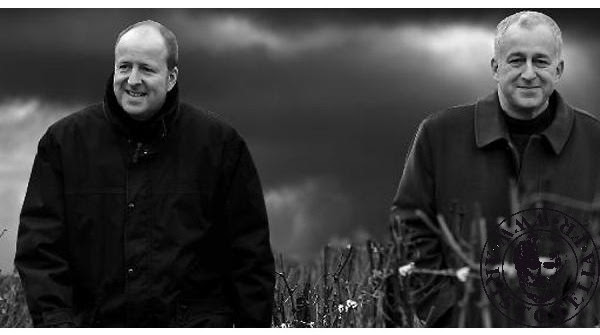
- - -
Posted on 2019.10.01 in France, The Champagne Society, Champagne | Read more...
Corsica, France’s Last Wine Frontier — the Grand Wines of Clos Canarelli + A One of a Kind Sparkling from Domaine Comte Abbatucci
We have been bringing in some of the most renowned producers from the island of Corsica for years and we are quite proud of the selection we have assembled. We are excited to share the newly-arrived, thrilling wines of Yves Canarelli, featuring both new vintages of wines we have previously brought in, as well as cuvées new to this market.
Despite Corsica being France’s most southerly vineyard area, it is surprisingly not its hottest. Height and wind modify the realities of latitude, demonstrated by the remarkable freshness of the best of Corsica’s white wines, and the almost Burgundian grace of its best reds.
 Possessing abundant freshness, complexity, and aromatic intensity, the wines of Yves Canarelli are some of the most celebrated and sought after from the island. He has always championed the restoration of native Corsican grapes. While the French government remains slow to reconsider appellation rules to allow for some of the oldest of these heirloom varieties, often forcing producers to bottle under the generic “Vin de France” designation, Yves nevertheless began tearing out entire vineyards of imported varieties and replanting with native vines shortly after taking over the family domaine in 1993. His latest ventures are with amphora-fermented wines.
Possessing abundant freshness, complexity, and aromatic intensity, the wines of Yves Canarelli are some of the most celebrated and sought after from the island. He has always championed the restoration of native Corsican grapes. While the French government remains slow to reconsider appellation rules to allow for some of the oldest of these heirloom varieties, often forcing producers to bottle under the generic “Vin de France” designation, Yves nevertheless began tearing out entire vineyards of imported varieties and replanting with native vines shortly after taking over the family domaine in 1993. His latest ventures are with amphora-fermented wines.
Clos Canarelli’s vines are located in the granite and red alluvial soil near the tiny, remote village of Tarabucetta, on the southern tip of Corsica in the appellation of Corse Figari. The ever-constant wind from the Gulf of Figari makes for challenging growing conditions, perhaps explaining why Yves Canarelli is one of only a handful of plucky producers there. Indeed, those ferocious winds help to keep the vines free from excess moisture and pests. Yves utilizes both organic and biodynamic viticulture. In the cellar, he prefers deliberate fermentations using indigenous yeasts. These wines not only advertise Corse Figari’s terroir, they exhibit the intrigue of world-class wine.
All prices based on the purchase of six or more bottles (mix and match).
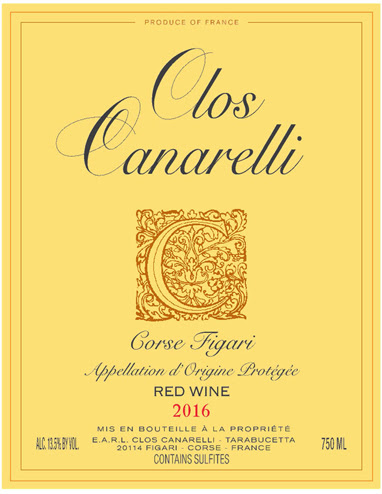 ~$44 Rouge (Corse Figari 2016) RED
~$44 Rouge (Corse Figari 2016) RED
A blend of mostly Niellucciu (closely related to the Italian Sangiovese) with around 15% each of Syrah and Sciacarellu. The fruit is from 19 acres of granitic soil with vines planted in 1997. The wine is raised in foudre for 14 to 18 months, and then bottled unfiltered. Ripe, red fruits blend with notes of spice and herbal maquis shrubland that grows on the hills of Corsica. Plum and cherry fruit show in abundance before leading to a hauntingly long and complex finish.
 ~$80 “Amphora” Rouge (Corse Figari 2017) RED
~$80 “Amphora” Rouge (Corse Figari 2017) RED
“Amphora” Rouge is a blend of predominately Niellucciu and Sciaccarellu with the addition of about 20% Minustellu, Carcaghjolu, and Moresconu, all from a 1.2 acre parcel of granitic soils. The wine is vinified in a clay amphora for four to seven weeks before finishing in stainless steel tanks and neutral wood barrel for seven to nine months. The wine is never filtered or fined and no sulfur is used at any time during the process. The result is a sensual wine with concentrated fruit, profoundly expressing this sunny, Mediterranean island.
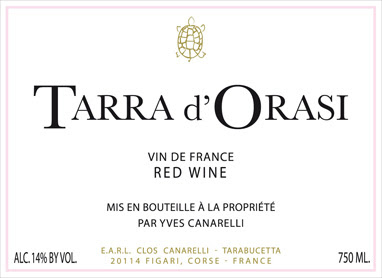 $126 “Tarra d’Orasi” Rouge (Vin de France 2015) RED
$126 “Tarra d’Orasi” Rouge (Vin de France 2015) RED
“Tarra d’Orasi” is produced from vines that are over 140 years old. It is a pre-phylloxera field blend where Sciaccarellu, Minustellu, and Cinsault are co-planted in a 0.6 acre, isolated vineyard of sand and granite. Fermented and vinified in large foudres for 14 to 18 months and bottled without filtering, the wine is rich, concentrated, and an epic expression of the island. This is one of the most unique wines in the world. As you might expect, production of this wine is miniscule, subsequently, we only have a small amount available.
 ~$49 “Biancu Gentile” (Corse Figari 2017) WHITE
~$49 “Biancu Gentile” (Corse Figari 2017) WHITE
Once widely grown in Corsica and famed for its aromatic complexity, Biancu Gentile was later neglected and left on the brink of extinction. At the time of its resurrection, it is estimated there was only a single acre left under vine. Now, with the help of Yves’ 1.2 acre vineyard, planted in 2000, the future of this variety is undeniable. The wine is aged in concrete eggs on its lees to coax out the richer texture and notes of exotic fruits, citrus, flowers, and Mediterranean breezes.
 ~$80 “Amphora” Blanc (Corse Figari 2017) WHITE
~$80 “Amphora” Blanc (Corse Figari 2017) WHITE
“Amphora” Blanc is 100% Vermentinu from a 1.2 acre parcel of granitic soils planted in 1997. At harvest, amphoras are filled directly with two-thirds must and one-third whole clusters and then fermented and aged for three months. The wine is then transferred to neutral barrels for a further three months of aging. The wine is never filtered or fined and no sulfur is used at any time during the process. Deep in color, flavor and aromatics, this intense wine is loaded with personality and length.
Domaine Comte Abbatucci Sparkling Wine

~$80 “Cuvée Empire” (Vin de France Extra Brut, 2015)
Did we already mention that Elie Wine is your Corsican connection? Where else are you going to find a sparkling wine produced from the five acre vineyard planted by Jean-Charles Abbatucci’s father, Antoine Abbatucci, in the early 1960s, in an effort to save indigenous grape varieties? “Cuvée Empire” is a blanc de noirs sparkling wine produced in the traditional method from 100% Barbarossa, a red/pink variety. Fermentation takes place in a 12,000 liter foudre and the wine is aged on its fine lees for four months. A secondary fermentation takes place in the bottle for another year. The Extra Brut dosage is 4 grams/liter. We are big fans of Jean-Charles’ unique and world-class wines and this one is no exception.
Click here to learn more about Jean-Charles Abbatucci and his other wines we have on offer.
- - -
Posted on 2019.09.26 in France, Saturday Sips Wines, Corsica | Read more...
Featured Wines
- Notebook: A’Boudt Town
- Saturday Sips Wines
- Saturday Sips Review Club
- The Champagne Society
- Wine-Aid Packages
Wine Regions
Grape Varieties
Aglianico, Albarín Blanco, Albillo, Aleatico, Alicante Bouschet, Aligote, Altesse, Arcos, Aubun, Auxerrois, Beaune, Bonarda, Cabernet Franc, Cabernet Sauvignon, Caino, Caladoc, Carignan, Chablis, Chardonnay, Chasselas, Chenin Blanc, Cinsault, Cortese, Corvina, Corvinone, Cot, Dolcetto, Ferrol, Fiano, folle Blanche, Frappato, Friulano, Fumin, Gamay, Garganega, Garnacha, Garnacha Tintorera, Godello, Grenache, Grenache Blanc, Grolleau, Jacquère, Lambrusco, Lladoner Pelut, Macabou, Maconnais, Malbec, Malvasia, Malvasia Nera, manseng, Marcelan, Melon de Bourgogne, Mencía, Merlot, Mondeuse, Montepulciano, Montònega, Morescola, Morescono, Mourv, Mourvèdre, Muscadelle, Nebbiolo, Nero d'Avola, Niellucciu, Palomino, Pecorino, Pedro Ximénez, Persan, Petit Verdot, Pinot Auxerrois, Pouilly Fuisse, Pouilly Loche, Poulsard, Prieto Picudo, Riesling, Rondinella, Rose, Rousanne, Roussanne, Sagrantino, Sangiovese, Sauvignon, Sauvignon Blanc, Savignin, Sciacarellu, Serine, Souson, Sylvaner, Syrah, Tannat, Teroldego, Timorasso, Trebbiano, Treixadura, trepat, Trousseau, vaccarèse, Viognier, ViuraWines & Events by Date
- September 2025
- August 2025
- July 2025
- June 2025
- May 2025
- April 2025
- March 2025
- February 2025
- January 2025
- December 2024
- November 2024
- October 2024
- September 2024
- August 2024
- July 2024
- June 2024
- May 2024
- April 2024
- March 2024
- February 2024
- January 2024
- December 2023
- November 2023
- October 2023
- September 2023
- August 2023
- July 2023
- June 2023
- May 2023
- April 2023
- March 2023
- February 2023
- January 2023
- December 2022
- November 2022
- October 2022
- September 2022
- August 2022
- July 2022
- June 2022
- May 2022
- April 2022
- March 2022
- February 2022
- January 2022
- December 2021
- November 2021
- October 2021
- September 2021
- August 2021
- July 2021
- June 2021
- May 2021
- April 2021
- March 2021
- February 2021
- January 2021
- December 2020
- November 2020
- October 2020
- September 2020
- August 2020
- July 2020
- June 2020
- May 2020
- April 2020
- March 2020
- February 2020
- January 2020
- December 2019
- November 2019
- October 2019
- September 2019
- August 2019
- July 2019
- June 2019
- May 2019
- April 2019
- March 2019
- February 2019
- January 2019
- December 2018
- November 2018
- October 2018
- September 2018
- August 2018
- July 2018
- June 2018
- May 2018
- April 2018
- March 2018
- February 2018
- January 2018
- December 2017
- November 2017
- October 2017
- September 2017
- August 2017
- July 2017
- June 2017
- May 2017
- April 2017
- March 2017
- February 2017
- January 2017
- December 2016
- November 2016
- October 2016
- September 2016
- August 2016
- July 2016
- June 2016
- May 2016
- April 2016
- March 2016
- February 2016
- January 2016
- December 2015
- November 2015
- October 2015
- September 2015
- August 2015
- July 2015
- June 2015
- May 2015
- April 2015
- March 2015
- February 2015
- January 2015
- December 2014
- November 2014
- October 2014
- September 2014
- August 2014
- July 2014
- June 2014
- April 2014
- March 2014
- February 2014
- January 2014
- December 2013
- November 2013
- October 2013
- September 2013
- August 2013
- July 2013
- June 2013
- May 2013
- April 2013
- March 2013
- February 2013
- January 2013
- December 2012
- November 2012
- October 2012

